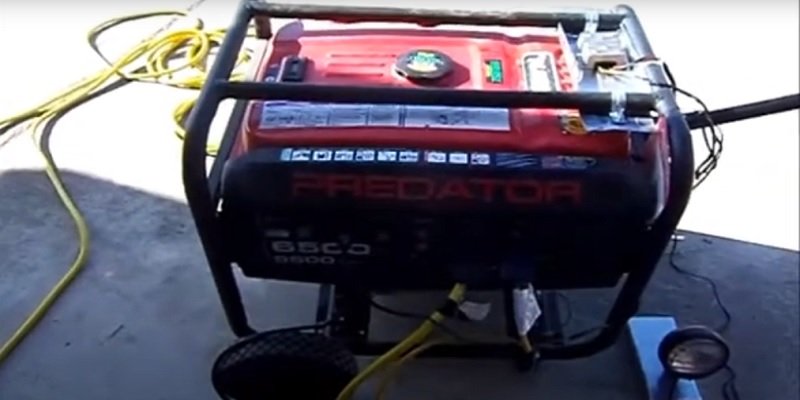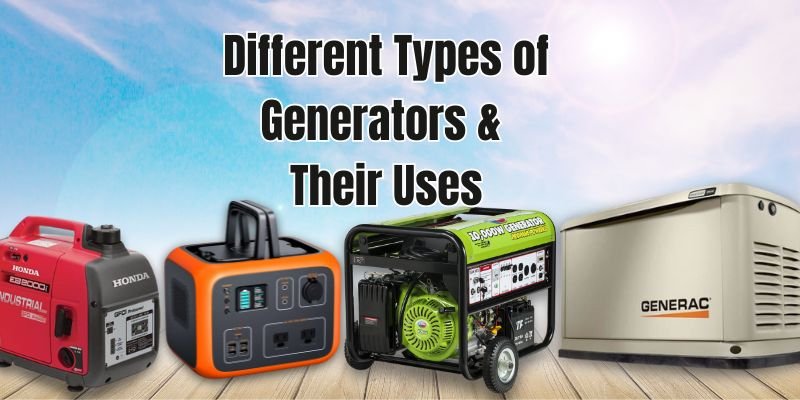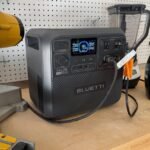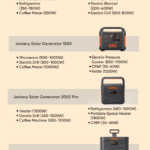Disclosure: This post contains affiliate links and I will be compensated if you make a purchase after clicking through my links. Learn More
To clean up generator power for electronics, use a power conditioner or a surge protector with voltage regulation. Properly grounding the generator is also essential.
Exploring The Potential Risks Of Using Generator Power For Electronics
When it comes to powering electronics with a generator, there are some potential risks that must be considered. Understanding these risks can help you take the necessary precautions to protect your sensitive electronic devices. In this article, we will explore the compatibility issues between generators and electronic devices, surges and fluctuations in generator power, and the high levels of harmonic distortion that can affect sensitive electronics.

Compatibility Issues Between Generators And Electronic Devices
Not all generators are compatible with all electronic devices. Different generators produce different types of power outputs, and if the power output is not suitable for your electronics, it can cause malfunctions, damage, or even complete failure. It is essential to ensure that the generator you are using is compatible with the specific voltage and frequency requirements of your electronic devices. Refer to the user manuals or consult with the manufacturers to determine the compatibility.
Surges And Fluctuations In Generator Power
Generator power can be prone to surges and fluctuations, which can have adverse effects on electronic devices. These sudden spikes or drops in voltage can potentially damage the sensitive electronic components or cause them to malfunction. It is highly recommended to use surge protectors or voltage regulators to safeguard your electronics from these irregularities in generator power. These protective devices can help stabilize the voltage and provide a consistent power supply to your electronics.
High Levels Of Harmonic Distortion Affecting Sensitive Electronics
Harmonic distortion refers to the occurrence of additional frequencies in electrical signals that can interfere with the proper functioning of sensitive electronic devices. Generators, especially those with older or poorly maintained engines, can produce increased levels of harmonic distortion. This distortion can lead to equipment overheating, reduced efficiency, and even damage to circuitry or components. To mitigate this risk, consider using power conditioners or harmonic filters to clean up the generator power and protect your electronics from harmful harmonic distortions.
Identifying Essential Steps For Safely Cleaning Up Generator Power
When using a generator to power electronic devices, it is crucial to take certain essential steps to ensure the safety and integrity of your electronics. Understanding how to clean up generator power is key to protect your valuable devices from potential damage or malfunction. In this article, we will delve into the necessary measures you should take when cleaning up generator power and highlight the significance of selecting the right generator, understanding power requirements and load capacity, using power conditioning and surge protection devices, and implementing grounding techniques. Let’s explore each of these steps in detail.
Selecting The Right Generator For Electronic Devices
Choosing the appropriate generator is the first and foremost step in ensuring that your electronic devices receive clean and stable power. Not all generators are designed to safely power sensitive electronics, so you need to be meticulous in your selection process. Look for generators that are specifically labeled as “sensitive electronic equipment-compatible” or “inverter generators.” These types of generators use advanced technology to produce high-quality power with minimal distortion and voltage fluctuations, making them safe for delicate devices.
Understanding Power Requirements And Load Capacity
Before connecting your electronic devices to a generator, it is essential to understand their power requirements and the generator’s load capacity. Power requirements can typically be found on the devices’ labels or user manuals. Ensure that the generator you choose has a power output rating sufficient to meet the cumulative demands of all the devices you intend to connect. Overloading a generator can lead to voltage drops, fluctuations, or even equipment damage. Keeping a careful eye on power requirements and load capacity will help maintain the integrity of your electronics.
Using Power Conditioning And Surge Protection Devices
Power conditioning devices, such as voltage regulators or power line conditioners, can be incredibly beneficial in cleaning up generator power. These devices help stabilize and regulate the voltage, eliminating spikes, surges, or fluctuations that can potentially harm your electronics. Surge protection devices, like surge protectors or power strips with surge protection, are another crucial component in safeguarding your devices against sudden spikes in voltage. By using these devices in conjunction with your generator, you can protect your electronics from any power abnormalities.
Implementing Grounding Techniques For Safety
Grounding is a crucial safety measure when it comes to working with generators. Proper grounding helps redirect electrical surges or stray currents into the ground, ensuring the safety of users and preventing damage to electrical equipment. Consult an electrician to help you establish a solid grounding system for your generator. This may involve installing grounding rods, connecting grounding wires, and adhering to the local electrical codes and regulations. Implementing grounding techniques will help mitigate the risks associated with electrical faults or malfunctions.
Ensuring Proper Connection And Grounding For Electronics
Proper Grounding Of Generator And Electrical System
When it comes to connecting your electronics to a generator, one of the crucial aspects to keep in mind is proper grounding. Without adequate grounding, your electrical system and electronic devices may be at risk of damage or malfunction. To ensure a safe and reliable connection, it is essential to follow specific guidelines for grounding your generator and electrical system.
- Inspect the grounding system of your generator to ensure it meets the necessary requirements. A properly grounded generator provides a path for electrical current to flow safely to the ground, preventing the buildup of potentially hazardous voltages.
- Check if your generator is equipped with a grounding terminal or lug. This terminal is typically located near the generator’s power outlets.
- Use a grounding wire of an appropriate size, as recommended by the generator manufacturer, to connect the grounding terminal of the generator to a designated grounding point in your electrical system.
Using Grounding Rods And Bonding All Equipment
Bonding all equipment and utilizing grounding rods are additional measures you can take to enhance the safety and performance of your electrical system when running electronics with a generator.
- Install grounding rods near the generator and main electrical panel, following the specific guidelines set by local electrical codes. These rods help to establish a solid grounding connection and protect against electrical faults.
- Ensure that all equipment, including the generator, electrical panel, and electronic devices, are properly bonded together. Bonding connects all the metal parts of the system, creating a common ground and reducing the risk of electric shock.
- Inspect and maintain all bonding connections regularly to ensure their integrity. Loose or corroded connections can undermine the effectiveness of the grounding system.
Implementing Ground Fault Circuit Interrupter (gfci) Protection
Another vital aspect of ensuring proper connection and grounding for your electronics is the implementation of ground fault circuit interrupters (GFCIs). GFCIs provide an extra layer of protection by detecting imbalances in electrical currents and interrupting the circuit if a ground fault occurs.
- Install GFCIs on individual outlets where the electronics will be connected. GFCI outlets are designed to recognize potential faults and shut off power to prevent electrical hazards.
- Regularly test GFCIs to ensure they are functioning correctly. Press the “test” button on the GFCI outlet to simulate a ground fault and verify that it shuts off power as intended. If a GFCI fails the test, replace it immediately.
- Consider using a portable GFCI device, such as a GFCI plug adapter, if your generator does not have built-in GFCI protection. These devices provide an extra level of safety by monitoring the flow of electricity and cutting off power during a ground fault.
Utilizing Surge Protectors And Voltage Regulators For Added Protection
When it comes to protecting your electronics from the potential dangers of generator power, utilizing surge protectors and voltage regulators is essential. These devices offer an additional layer of defense against power fluctuations, voltage spikes, and surges that can wreak havoc on your valuable electronic equipment. In this section, we will explore the importance of choosing surge protectors with high joule ratings, investing in quality voltage regulators for stable power supply, and considering automatic voltage regulation for consistent voltage output.
Choosing Surge Protectors With High Joule Ratings
When selecting a surge protector for your electronics, it’s crucial to pay attention to the joule rating. The joule rating indicates the amount of energy the surge protector can absorb before it becomes overwhelmed. Opting for a surge protector with a high joule rating ensures that it can effectively handle power surges and protect your devices from damage.
Investing In Quality Voltage Regulators For Stable Power Supply
A voltage regulator is a valuable investment when it comes to cleaning up generator power for your electronics. These devices work by stabilizing the voltage output, ensuring that your electronics receive a consistent and safe power supply. By regulating voltage fluctuations, voltage regulators protect your electronics from potential damage caused by unstable power.
Considering Automatic Voltage Regulation For Consistent Voltage Output
Automatic voltage regulation takes voltage regulation to the next level by automatically adjusting the output voltage to maintain a consistent level. This feature is beneficial when using generator power, as it compensates for any variations in voltage that may occur. With automatic voltage regulation, you can rest assured that your electronic devices are receiving a steady and reliable power supply, mitigating the risk of damage due to inconsistent voltage.
Regular Maintenance And Testing To Ensure Optimal Performance
When it comes to using a generator to power your electronics, regular maintenance and testing are crucial to ensure the optimal performance and longevity of the equipment. By following a few simple steps, you can keep your generator and electronics running smoothly and efficiently, avoiding any potential issues that may arise due to improper power supply.
Cleaning Generator And Fuel System
One of the primary steps in maintaining your generator is keeping it clean. Over time, dirt, debris, and dust can accumulate on the equipment, hindering its performance. Regular cleaning not only improves the generator’s efficiency but also helps in preventing any potential damage to sensitive electronic components.
To clean your generator, follow these steps:
- Switch off the generator and disconnect it from the power source.
- Remove any loose debris or dirt from the exterior using a soft brush or cloth.
- For more stubborn stains, use a mild detergent mixed with water to gently clean the surface.
- Thoroughly dry the generator before reconnecting it to the power source.
In addition to cleaning the generator itself, it is essential to keep the fuel system free from any contaminants. Regularly inspect the fuel filters and replace them if they show signs of clogging or excessive dirt accumulation. Always ensure that the fuel used is clean and of the recommended grade to optimize the generator’s performance.
Performing Load And Voltage Tests Periodically
Load and voltage testing are crucial to determine the generator’s capacity to supply power to your electronics effectively. These tests help identify any potential issues that may affect the generator’s performance and the quality of power supplied to your devices. By conducting these tests periodically, you can ensure that your generator is functioning optimally and providing stable power output.
To perform load and voltage tests, follow these steps:
- Disconnect all electronic devices from the generator.
- Connect a load bank or appropriate load testing equipment to the generator.
- Gradually increase the load while monitoring the generator’s voltage output.
- Ensure that the generator can handle the intended load without a significant drop in voltage.
- If the voltage drops excessively during the test, it may indicate an issue that requires further inspection or repair.
Inspecting And Replacing Worn-out Parts Or Cables
Regular inspection of your generator’s components and cables is essential to identify any signs of wear and tear. Worn-out parts or damaged cables can result in poor power quality, leading to potential damage to your electronics. By inspecting and replacing these components in a timely manner, you can maintain the optimal performance of your generator and ensure the safety of your devices.
When inspecting your generator, pay attention to the following:
- Check for any loose or corroded connections. Tighten or clean them as necessary.
- Inspect cables for any signs of fraying, cracking, or exposed wires. Replace damaged cables immediately.
- Examine the generator’s internal components for any signs of wear, damage, or build-up of dirt and debris. Clean or replace as needed.
By following these regular maintenance and testing practices, you can keep your generator in optimal condition and ensure that it reliably powers your electronics. Remember to consult the manufacturer’s guidelines for specific maintenance procedures and frequencies. With proper care, your generator will continue to provide a reliable and stable power supply for your electronic devices.
Training And Education For Safe Handling Of Generator Power
One of the most crucial aspects of using generator power for electronics is ensuring that users are well-educated about the potential risks and precautions. By providing comprehensive training and education, users can confidently handle generator power while protecting their valuable electronic devices. This section explores the importance of educating users about potential risks and precautions, providing guidelines for proper usage and maintenance, as well as conducting safety drills and emergency preparedness training.
Educating Users About Potential Risks And Precautions
When it comes to generator power, users need to be aware of the potential risks and hazards that may arise. Educating them about these risks is crucial to prevent accidents and damage to sensitive electronics. By conducting training sessions and workshops, users can develop a clear understanding of the dangers associated with generator power and learn how to mitigate them effectively.
Providing Guidelines For Proper Usage And Maintenance
To ensure the safe handling of generator power for electronics, it is essential to provide users with clear guidelines on proper usage and maintenance. These guidelines should cover aspects such as connecting electronics to the generator, selecting the appropriate voltage, and managing power fluctuations. By following these guidelines, users can minimize the risk of electrical damage and maintain the longevity of their electronic devices.
Moreover, regular maintenance is vital to keep the generator in optimal condition. Educating users about routine inspection and maintenance tasks, such as checking fuel levels, oil changes, and air filter cleaning, will help them identify and address potential issues before they escalate. Proper maintenance not only enhances generator performance and reliability but also reduces the likelihood of power surges or voltage fluctuations that could harm electronics.
Conducting Safety Drills And Emergency Preparedness Training
In the event of a power outage or other emergencies, it is crucial for users to have the necessary skills and knowledge to handle generator power safely. By conducting safety drills and emergency preparedness training, users can familiarize themselves with the proper steps to take during such situations. This includes knowing how to start and stop the generator safely, understanding the importance of proper ventilation, and being aware of the risks of carbon monoxide poisoning.
Additionally, users should be trained on how to recognize warning signs of a malfunctioning generator, such as unusual noises or smells, and how to respond promptly to avoid potential hazards. Emergency preparedness training equips users with the ability to handle unforeseen circumstances effectively, ensuring the safety of both themselves and their electronic devices.
To conclude, training and education play a critical role in ensuring the safe handling of generator power for electronics. By educating users about potential risks and precautions, providing guidelines for proper usage and maintenance, and conducting safety drills and emergency preparedness training, the chances of accidents or damage to electronics can be significantly reduced. An informed and aware user is better equipped to handle generator power responsibly and protect their valuable electronics from potential harm.
Frequently Asked Questions For How To Clean Up Generator Power For Electronics?
Is Generator Power Safe For Electronics?
Generator power is generally safe for electronics, as long as you use a quality generator and follow proper voltage regulations. Make sure you connect your electronics through surge protectors to prevent voltage spikes, and avoid overloading the generator to maintain a stable power supply.
Will A Generator Mess Up Electronics?
Generators can potentially damage electronics. Use surge protectors and voltage regulators to prevent any harm.
What Is Considered Clean Power From A Generator?
Clean power from a generator refers to electricity produced with minimal environmental impact. It is generated using renewable sources like solar, wind, or hydro. This type of power reduces carbon emissions, air pollution, and dependence on fossil fuels. It helps create a sustainable and greener energy future.
How Do You Make A Generator Power Clean?
To keep a generator clean and running smoothly, follow these tips: 1. Regularly clean the exterior of the generator with a damp cloth. 2. Keep the surrounding area free from dirt, dust, and debris. 3. Check and change the air filter as recommended by the manufacturer.
4. Use clean fuel and add a fuel stabilizer if needed. 5. Schedule regular maintenance and servicing with a qualified technician.
Final Words
Ensuring clean and stable power supply to electronics when using a generator is crucial for their optimal performance and longevity. By following the steps outlined in this guide, you can effectively clean up generator power and safeguard your valuable electronic devices.
Remember to regularly maintain your generator and use appropriate power conditioning equipment to eliminate any electrical noise or interference. With these precautions, you can enjoy uninterrupted power supply while keeping your electronics safe.








